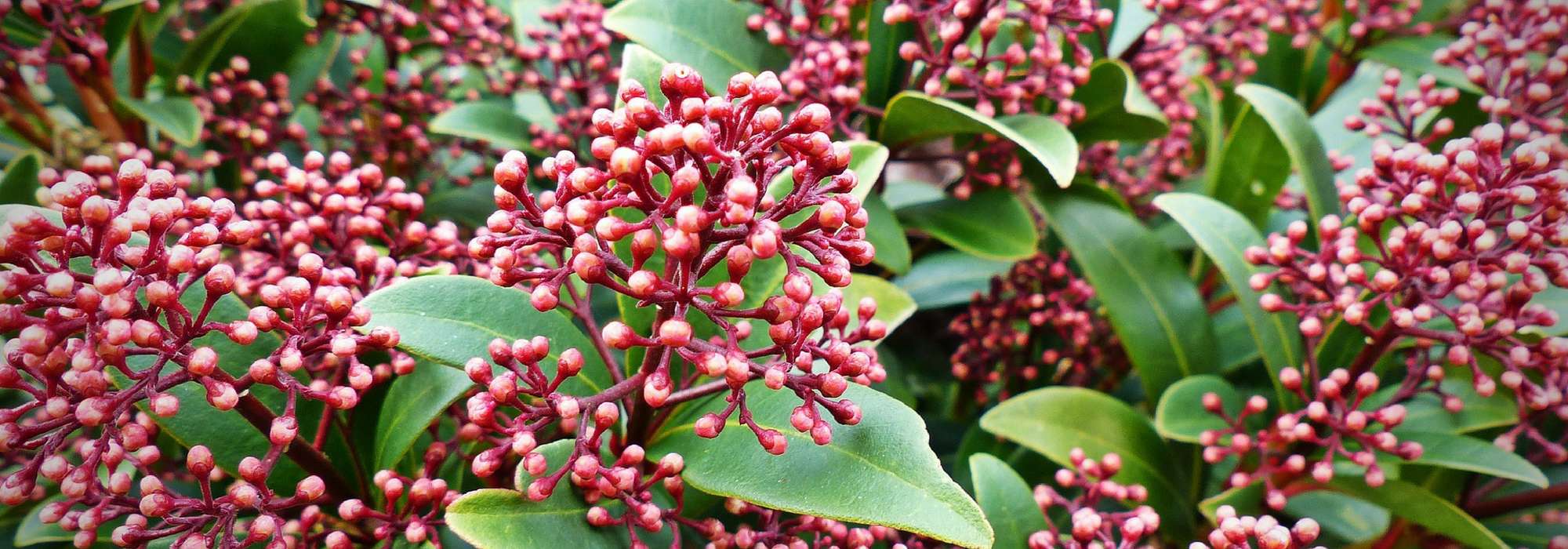
Skimmia : planting, pruning and care
Contents
Skimmia, in a nutshell
- Skimmias are small evergreen and hardy bushes, easy to grow and virtually foolproof.
- Their use in groups is common as they form an easy-to-grow ground cover, tolerating pollution well.
- They remain pristine throughout winter and are valuable for elegantly decorating a terrace or border.
- The flowering in March-April occurs in small whitish or pinkish-white clusters, fragrant.
- They are appreciated for the profusion of red or ivory-white berries that enliven the foliage from November to April.
A word from our expert
Skimmias are small, low-maintenance bushes that are very easy to grow, rewarding us with an early flowering that is both generous and delicate. The tight clusters of small white, pinkish, or greenish flowers with a subtle fragrance beautifully adorn the tops of the stems. The foliage is aromatic as well. This low-growing shrub, maintained between 60 cm and 1.5 m in height, will create a lovely display alongside bulbs of daffodils, grape hyacinths, and crocuses, whether on a balcony or in a shaded bed.
Its fine pinkish inflorescences also play a moderating role in heather soil beds, tempering the brightness of azaleas, rhododendrons, and camellias. They can be used without limit to bridge two vibrant flowerings, create dark green patches dotted with red or white berries among heathers, or highlight shrubs with colourful juvenile foliage throughout the year.
Skimmias thrive in acidic or neutral soil, even slightly calcareous, kept fresh with regular watering. They are capable of colonising difficult areas, such as the base of bamboo. Their use in groups is common in public gardens as they form an interesting ground cover and tolerate pollution, cold, and wind exceptionally well.
Description and Botany
Botanical data
- Latin name Skimmia japonica
- Family Rutaceae
- Common name Japanese Skimmia
- Flowering March-April
- Height between 80 cm and 1.50 m
- Sun exposure shade, partial shade
- Soil type acidic or neutral, humus-bearing, cool and well-drained
- Hardiness good
The genus Skimmia comprises only 4 species of bushes found in Japan, Taiwan, the Philippines, and the Himalayan region extending to eastern Siberia. The species japonica, native to Japan, Sakhalin, China, and Southeast Asia, is the one that has given rise to the main cultivars. It can reach 6 m in all directions in its natural undergrowth habitat, but horticultural forms rarely exceed 80 cm to 1.50 m. Note that it grows as an epiphyte on old trunks of Cryptomeria japonica, particularly on Yakushima Island (Japan).
Skimmia belongs to the Rutaceae family, just like citrus trees and rue, characterised by the presence of essential oil glands on the laminae, visible by transparency. The alternate, evergreen leaves, measuring 8 to 12 cm long, are therefore aromatic, lanceolate in shape and quite leathery, with a glossy surface and marked main vein. The dark green colour of the typical species sometimes takes on a purplish hue, olive green variegated with cream in ‘Magic Marlot’, bright green edged with red in ‘Rubella’, and light green with emerald margins in Skimmia japonica subsp. reevesiana ‘Robert Fortune’…
These bushes are dioecious, meaning that male and female flowers are on separate plants. However, some cultivars are hermaphroditic, such as ‘Robert Fortune’. Thus, the variety ‘Rubella’ is a male clone that does not produce fruit but is of interest for the exceptional duration of its flowers in red buds. The inflorescences are composed clusters (thyrses) that are upright and sparkling, measuring 5 to 10 cm, consisting of small round buds often coloured red or green in both sexes. The open flowers, measuring 2-3 mm in diameter, have 4 sepals, 4 petals, 1 pistil, or 4 stamens. They emit more or less pronounced scents of vanilla and orange and are highly melliferous.
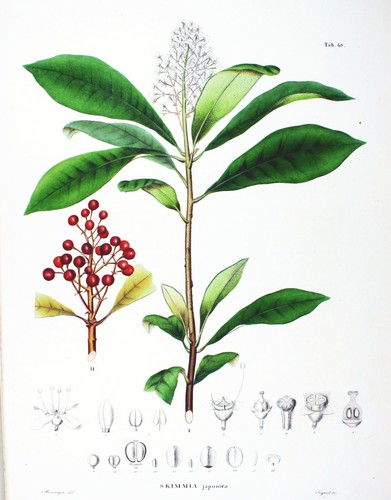
Skimmia japonica – botanical illustration
The fruits are ovoid or globular drupes that are bright red or white (black in Skimmia laureola), very decorative throughout the winter, from November to April. Fertilization occurs on female plants only if male plants are growing nearby.
Skimmias benefit from slow growth, around 10 to 15 cm per year, which generally results in a dense bush of 1.50 m in all directions at maturity. They can be cultivated in the ground or in pots due to their shallow root system. You can plant them as solitary specimens in a small garden, but they perform better in groups as ground cover, particularly Skimmia japonica ‘Rodgersii’, or as a low to medium hedge plant. They pair well with other heather soil shrubs, thus extending the appeal of a flowerbed or a pot arrangement on a balcony or terrace during the beautiful season. Flowering stems, in buds or fruits, are easily used in bouquets or for creating Christmas wreaths.
Skimmias thrive in shade or partial shade in a humus-bearing acidic to slightly alkaline, fairly rich and cool soil. They are quite resistant to air pollution and tolerate sunny exposure if the soil remains cool, as they do not like dryness.

Evolution of a flower of Skimmia japonica.
Read also
Aucuba: planting, pruning and careThe main varieties of skimmias
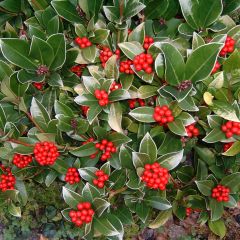
Skimmia reevesiana
- Flowering time April, May
- Height at maturity 1 m
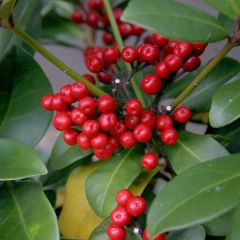
Skimmia japonica Veitchii
- Flowering time May, June
- Height at maturity 1,50 m
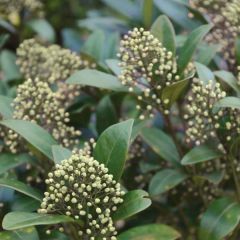
Skimmia japonica Kew Green
- Flowering time May, June
- Height at maturity 1 m
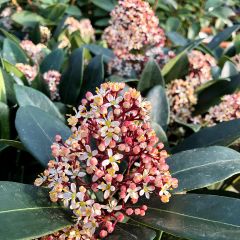
Skimmia japonica Rubella
- Flowering time May, June
- Height at maturity 1,20 m
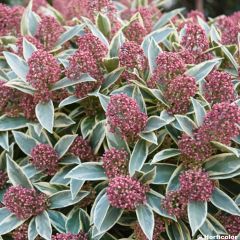
Skimmia japonica Mystic Marlot
- Flowering time May, June
- Height at maturity 60 cm
Discover other Skimmia
View all →Available in 0 sizes
Available in 3 sizes
Available in 1 sizes
Available in 1 sizes
Available in 1 sizes
Available in 1 sizes
Available in 1 sizes
Available in 1 sizes
Available in 1 sizes
Available in 1 sizes
Young plantation
Where to plant skimmias?
Skimmia japonica are quite tolerant of soil pH, although they are typically associated with ericaceous plants. They accept a slightly calcareous soil even though they have a preference for heather soil. However, a humus-bearing soil ensures the fertility and freshness necessary for skimmias. The soil must be drained.
Choose a shaded, semi-shaded spot or a light woodland area. A sunny area may be suitable if the soil remains cool. Skimmia does not appreciate cold drafts.
The foliage may yellow if the exposure is too sunny or if the soil is poor and dry.
When to plant?
Although it is possible to plant container-grown skimmia at any time of the year, ideally, it is best to do so in September-October or March-April. Avoid planting during frost and extreme heat.
How to plant?
If you wish to enjoy the fruiting of skimmia, plant a male plant such as ‘Rubella’ next to a female plant like ‘Veitchii’ or ‘Foremanii’. In mass planting, count at least one male plant for every seven female plants. Manual pollination by rubbing a bouquet of male flowers with yellow stamens on the female inflorescences is much more effective!
- Space the plants 1 metre apart or 80 cm apart for quicker ground cover.
- Moisten the root ball to facilitate recovery.
- Dig a planting hole, two to three times the size of the root ball. Add some well-decomposed compost.
- Place the plant in the planting hole at soil level.
- Replace the soil and lightly firm it down.
- Water.
- Spread a layer of pine bark each spring to maintain good freshness and acidity around the roots. This will also limit the growth of weeds.
For container cultivation, place a drainage layer of 3-4 cm at the bottom of the pot (gravel, broken pottery, etc.). Add a mix of heather soil or potting soil and garden soil.
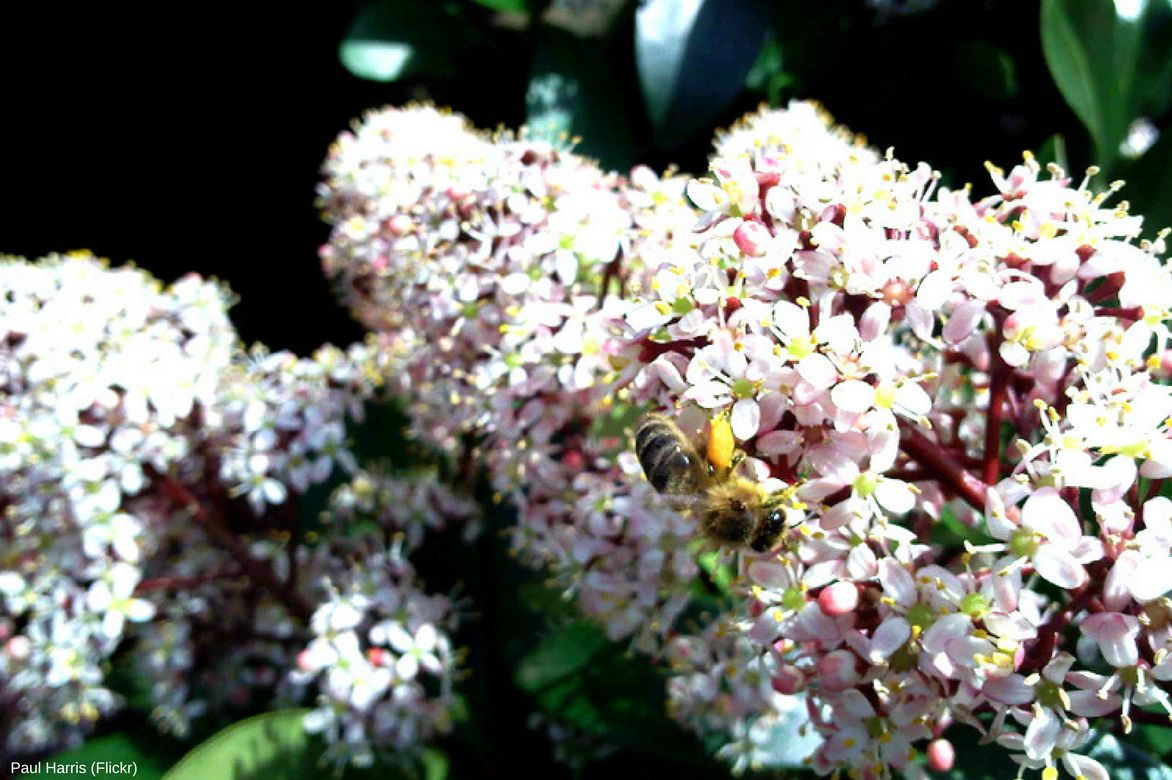
Skimmia flowers are melliferous.
Read also
Plant young ericaceous plantsMaintenance and care
Skimmia require very little care once they are established. Pruning is unnecessary as they grow slowly; however, you can pinch the tips after flowering to give them a more compact habit with a shear. Remove any unsightly or damaged branches using a small pruning shear.
Maintaining a trimmed hedge requires little upkeep. Perform a single pruning after flowering, knowing that fruits will not form in this case.
Japanese skimmia is known to be very resistant to pests and diseases. However, it may suffer from attacks by mealybugs, which can be eliminated by wiping with a cloth soaked in 90° alcohol or by spraying with a solution containing a teaspoon of black soap, a teaspoon of alcohol, and rapeseed oil.
Late frosts can cause a temporary yellowing of the leaves.
Excess lime leads to iron deficiency, resulting in discoloration of the leaves except at the veins (chlorosis). To remedy this, apply a layer of blonde peat, heather soil, or pine needles on the surface.

Skimmia japonica ‘Kew Green’ with small, highly fragrant white flowers.
Multiplying skimmias: propagation by cuttings, sowing
You can propagate skimmia by propagation by cuttings in summer or by sowing in September. Propagation by cuttings is the best technique, as it will yield young plants more quickly, ensuring that they are identical to the original variety.
Propagation by Cuttings
Skimmia can be propagated by cuttings in July-August-September using semi-ripe shoots.
- Prepare a pot by filling it with potting mix mixed with sand, or take your cuttings in open ground if it is light, after aerating it with a fork, then moisten the medium.
- Take a shoot about 7 cm long from a current year’s growth.
- Remove the leaves near the base of the cutting, and trim the others to leave only 2 or 3 leaves.
- Dip the base of the stem in plant hormone.
- Make a hole in the medium using a pencil or a wooden stick.
- Place the cutting in the hole and gently firm the soil around it to eliminate air pockets and ensure good contact between the potting mix and the cutting.
- Place under a frame in a warm, bright location but out of direct sunlight or cover the pot with a plastic bag to maintain a humid atmosphere.
- Ventilate occasionally to prevent the development of fungal diseases.
- Transplant the rooted cuttings in spring into a richer medium and grow them for at least 2 to 4 years before placing the plants in their final location.
Sowing
- Harvest the seeds in spring when the berries are fully ripe.
- Remove the flesh surrounding the seed and sow under a cold frame.
Use and combine them in the garden
Evergreen skimmias with glossy dark green leaves create lovely understorey scenes at the base of a Japanese maple with colourful young shoots, accompanied by Pieris, Enkianthus, rhododendrons, or azaleas that ensure a vibrant spring flowering.

An idea for an association to brighten an acid soil understorey: Skimmia japonica ‘Rubella’, Acer palmatum ‘Atropurpureum’, Enkianthus campanulatus, Pieris japonica ‘Debutante’, Rhododendron ‘Bernstein’.
The cultivar ‘Kew Green’, resembling bay laurel and reaching heights of 50 cm to 1 m, emits intense fragrant notes and pairs wonderfully with autumn-flowering Naples cyclamen, bergenias, or spring-flowering erysimums.
For a winter scene, combine skimmia, with its winter berries and early flowers, with early camellias, fragrant golden-flowering Hamamelis, and winter heathers.
We have envisioned an enchanting tableau with sparkling and shimmering tones to subtly frame and animate Skimmia reevesiana, which can be used alone or in groups as a vegetative frieze. Create a light, almost transparent backdrop with heavenly bamboo (Nandina japonica), whose red flowering and fruiting will echo those of the skimmia, then in the foreground, compose patches of apple green and dark red with a few clumps of lady’s mantle and parrot tulip bulbs.

An idea for an association: Skimmia reevesiana, Nandina domestica ‘Gulf Stream’, Alchemilla mollis, Parrot tulip ‘Estella Rijnveld’.
A large planter can accommodate a Skimmia japonica, an Euonymus fortunei ‘Harlequin’, and an Andromeda polifolia ‘Glauca Major’.
Did you know?
The name “skimmia” comes from its common name “shikimi” in Japanese. It is also the name of the state of Sikkim located in the western Himalayas in India.
Robert Fortune, responsible for introducing the tea plant to India, thereby breaking China’s monopoly on tea, introduced Japanese skimmia to Great Britain in 1861. The cultivar ‘Rubella’ was brought back to France by Eugène Simon (1848-1924) from China.
To go further
Discover our wide range of skimmias
Frequently asked questions
-
The leaves of my skimmia are turning yellow. Why?
Several factors can cause leaf yellowing: - a late frost, but the plant quickly greens up as temperatures rise, - soil that is too dry and poor: add compost or potting soil to make the soil more fertile and moist, - an excess of lime: add blonde turf, heather soil, or a mulch of pine needles.
- Subscribe!
- Contents
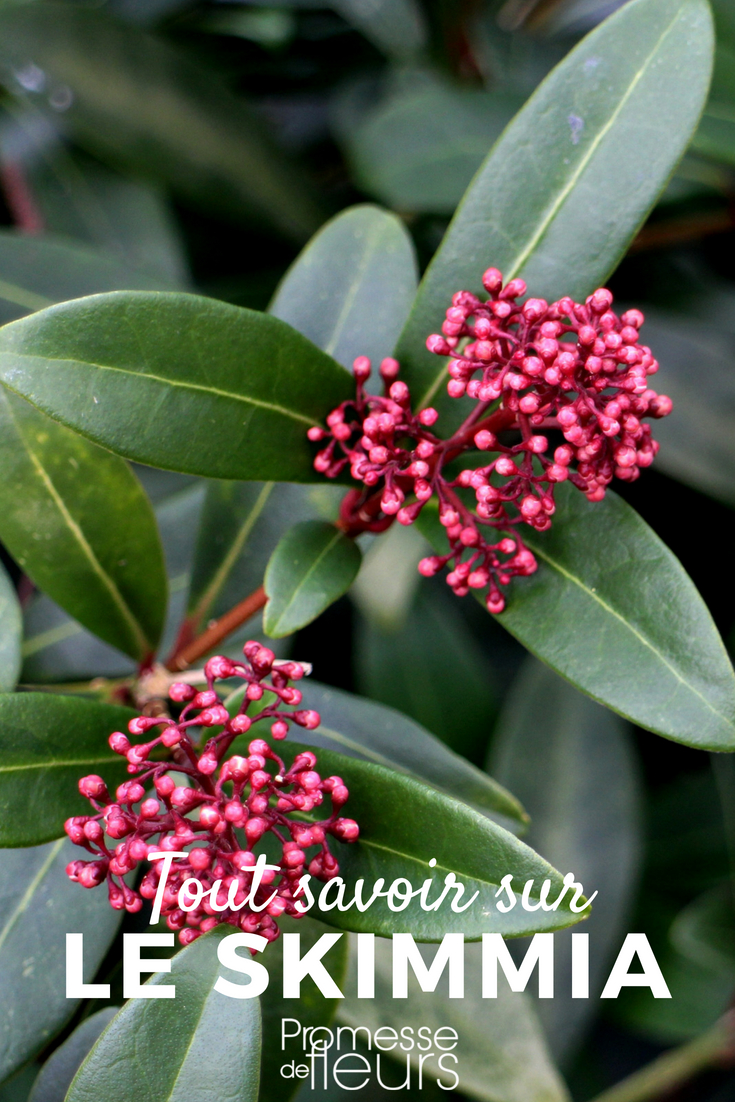






























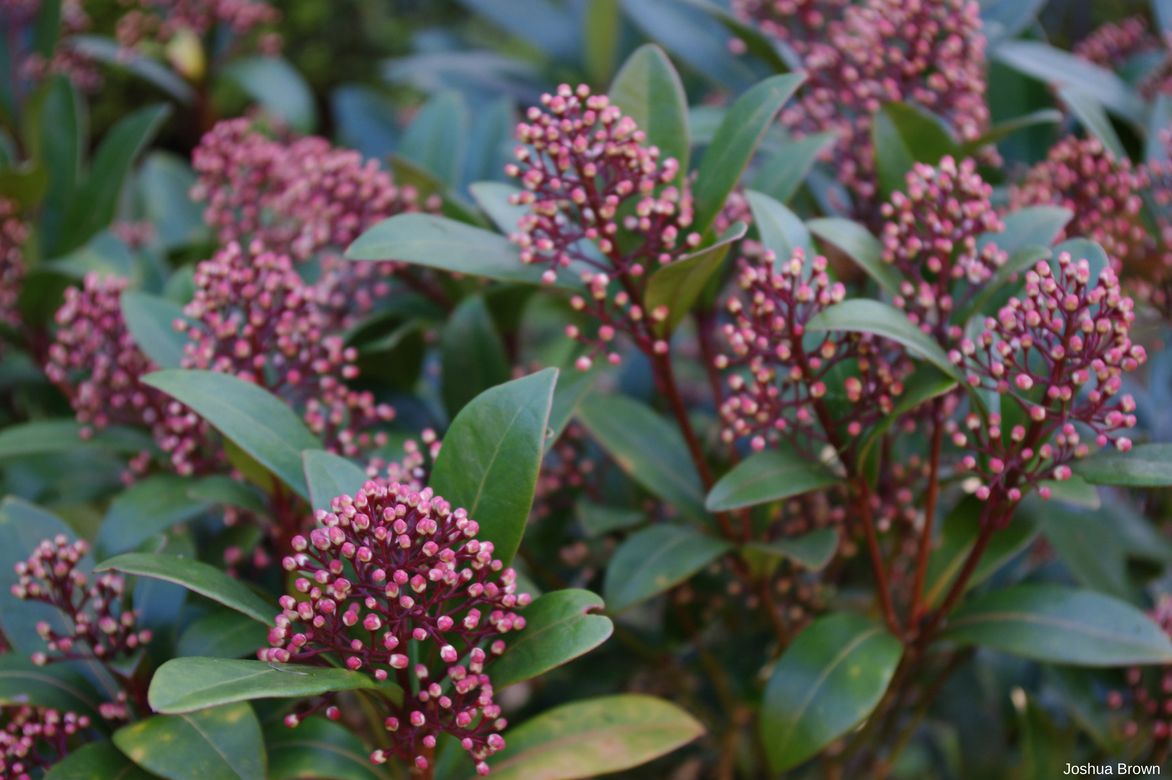

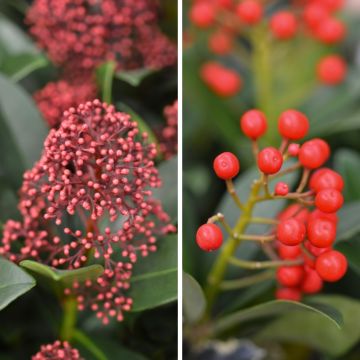


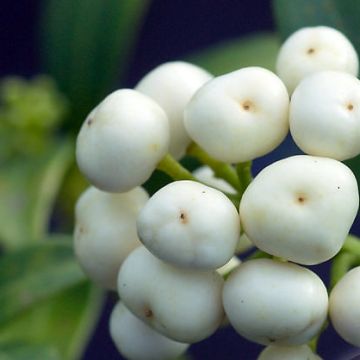
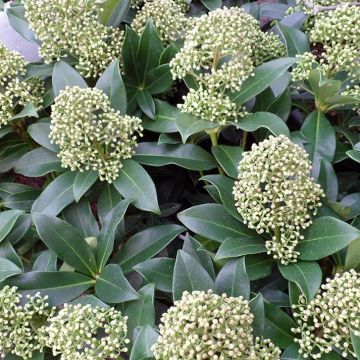

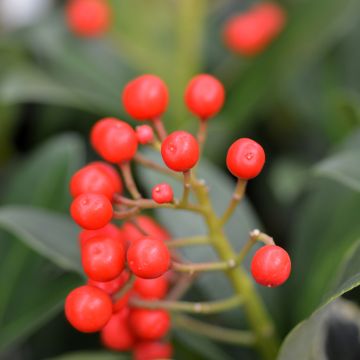
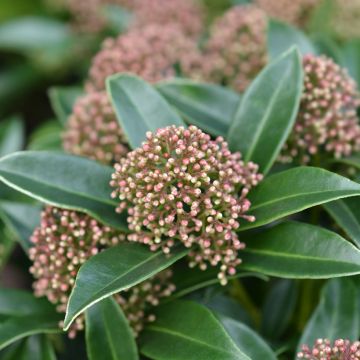


Comments